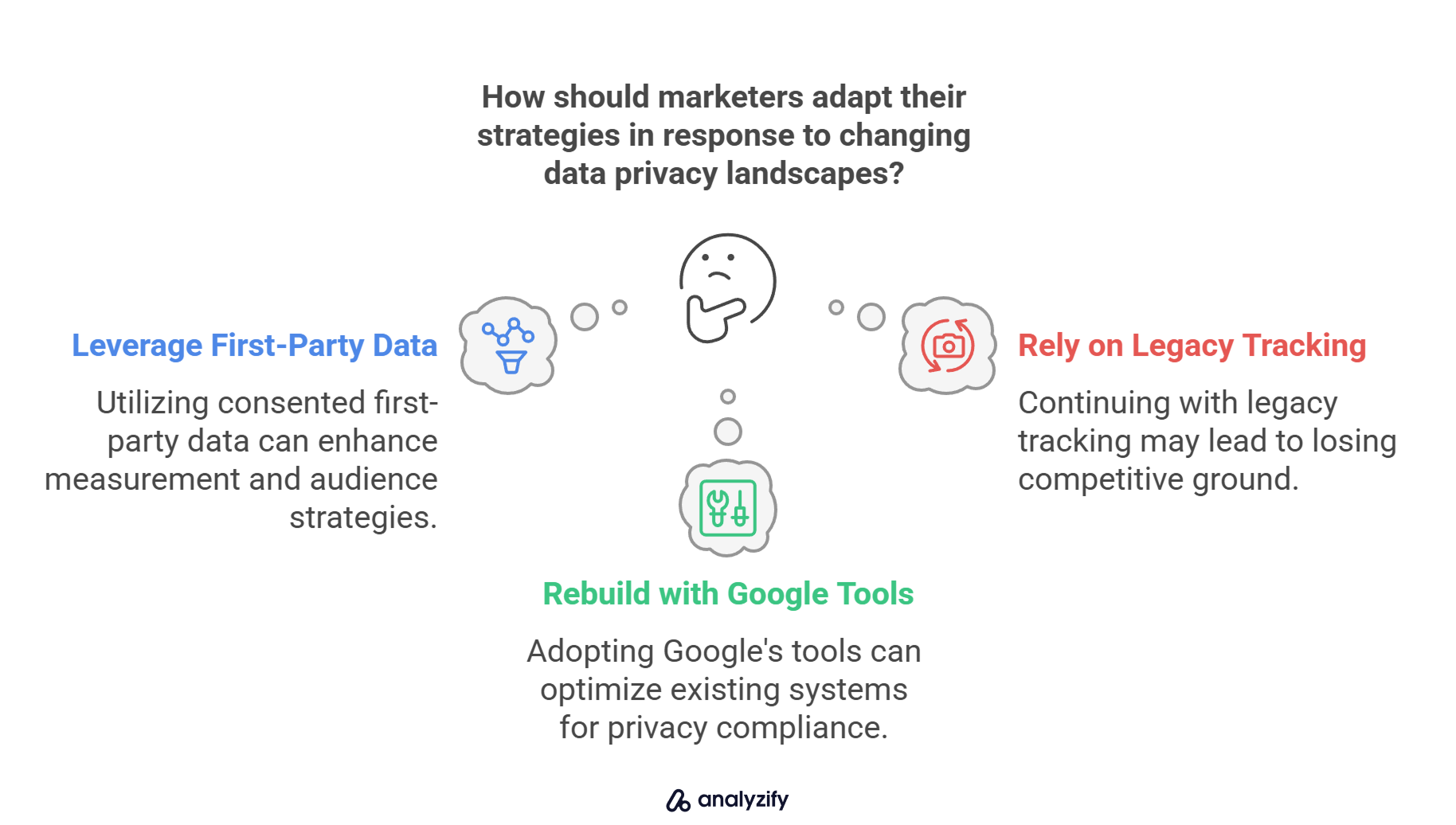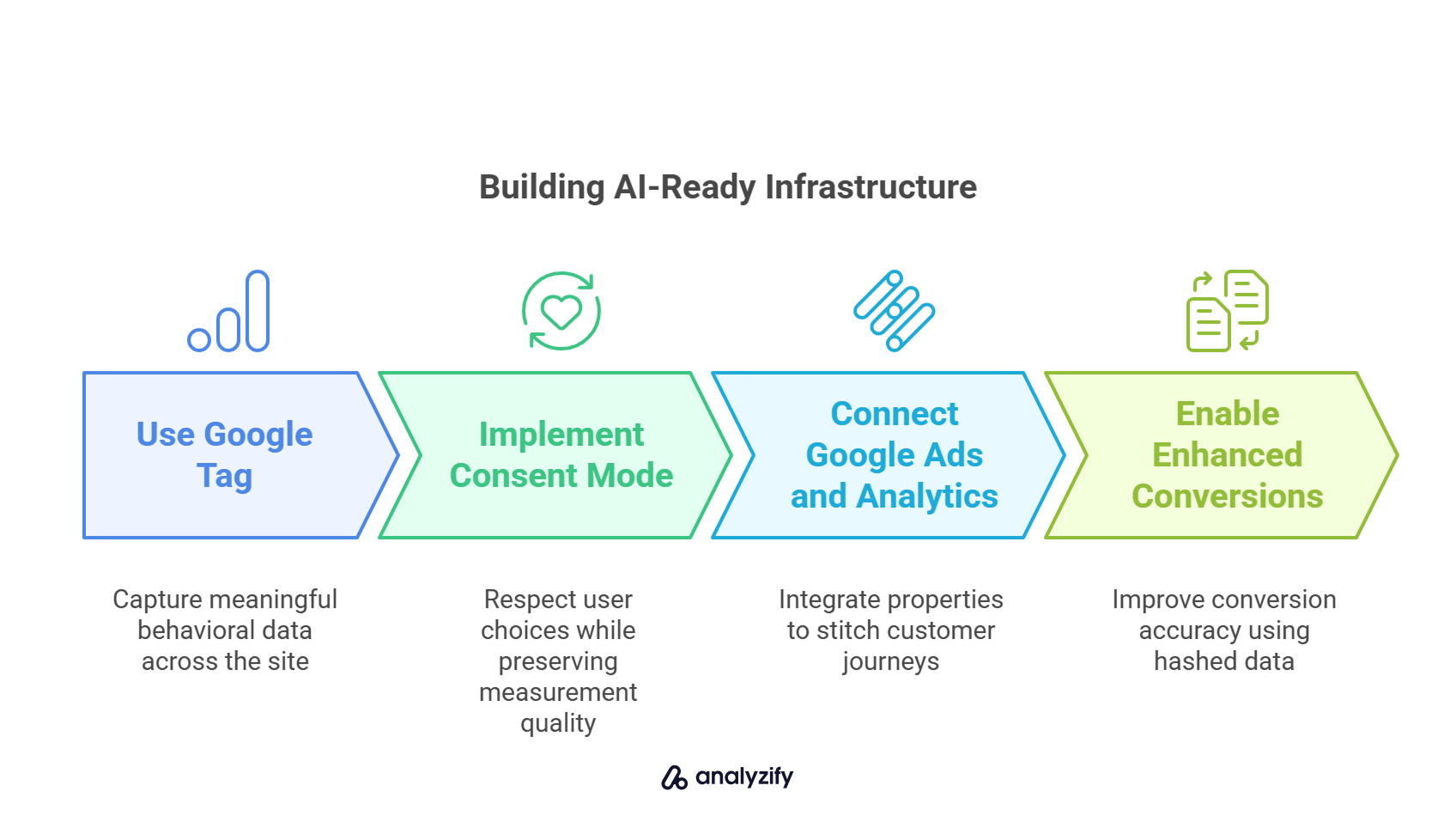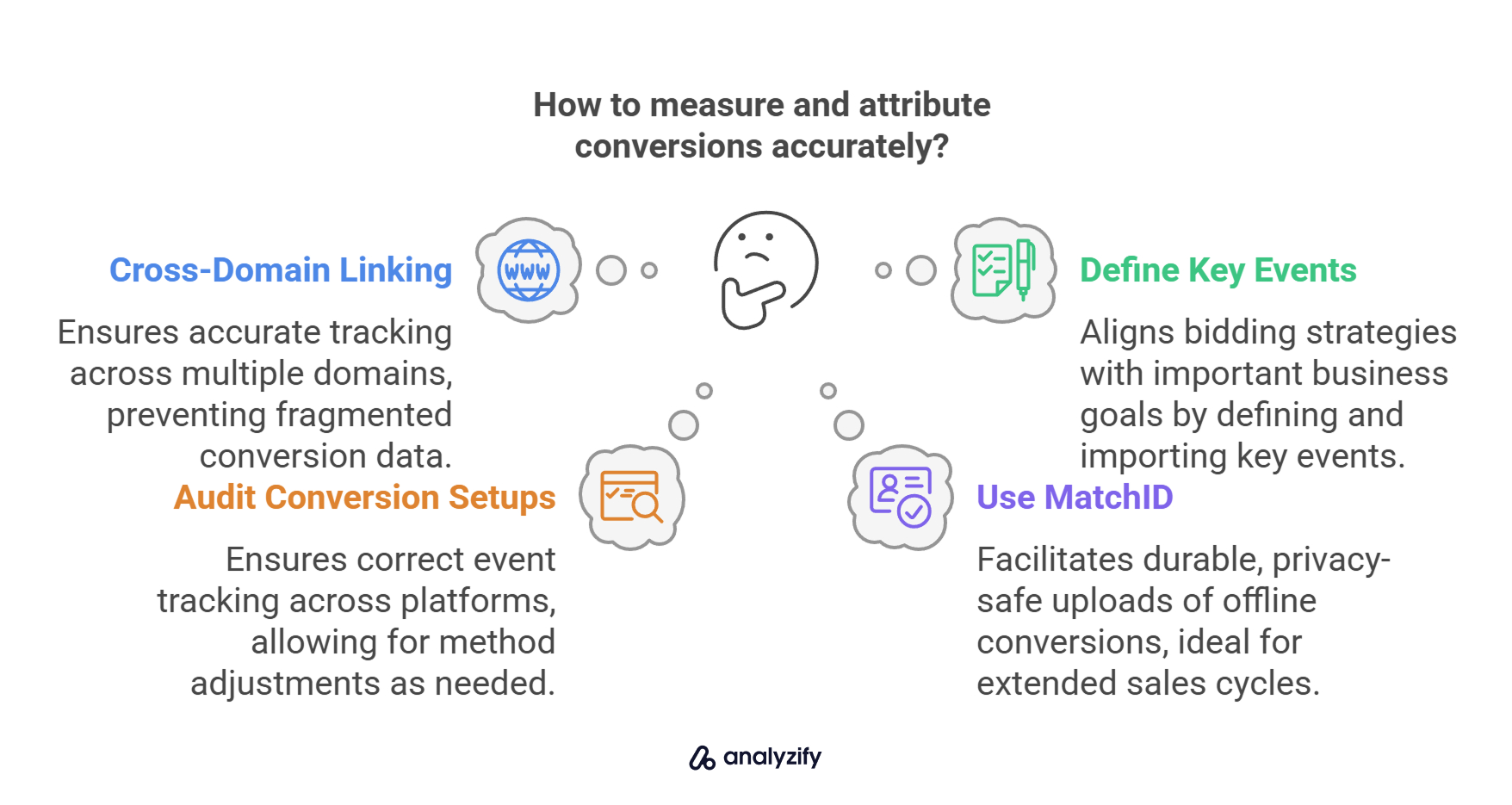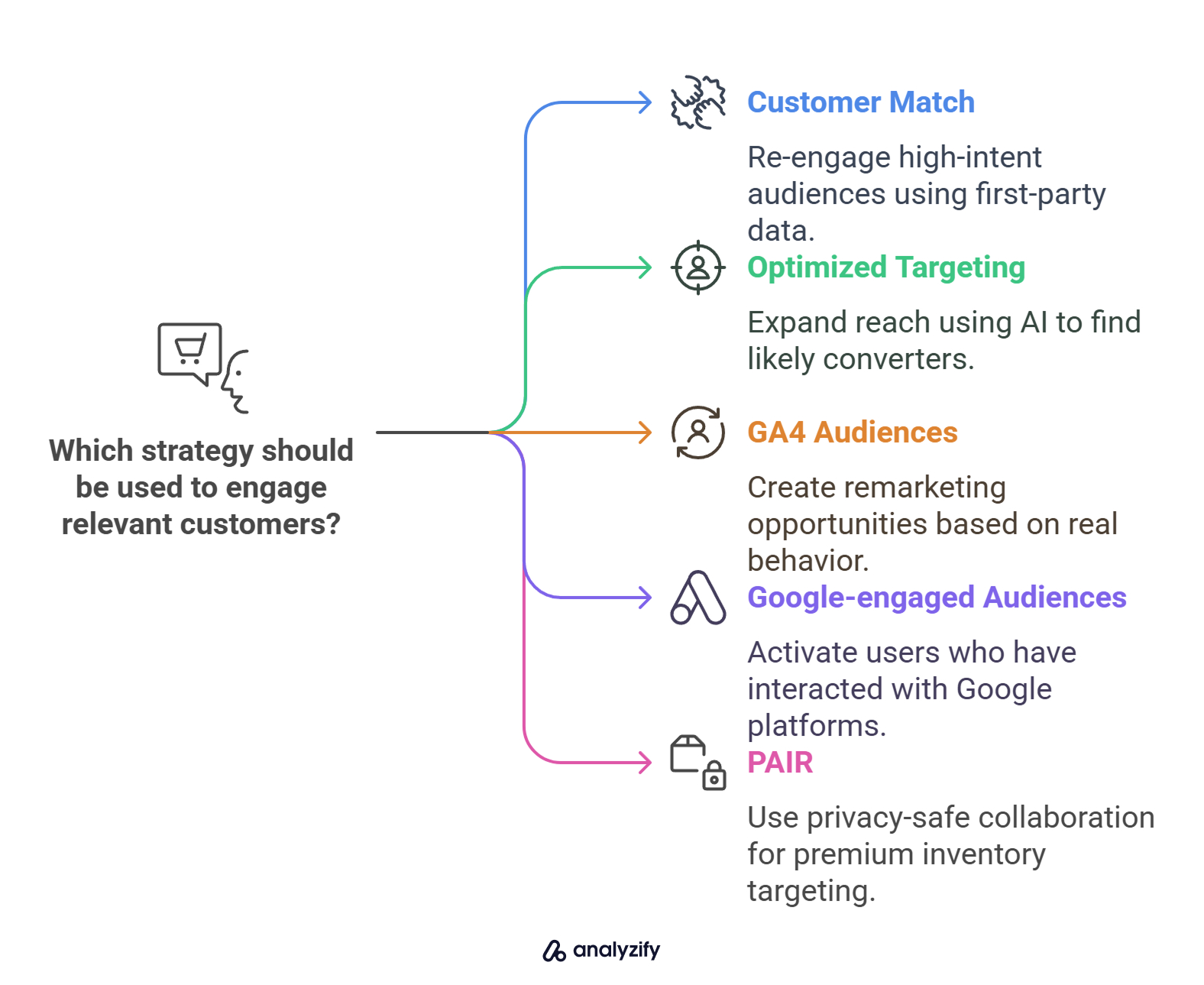Google reports that marketers who activate first-party data as an AI enabler see up to a 30% lift in performance. But that kind of return isn’t automatic—it depends entirely on the quality of the data that powers your AI.
The biggest unlock isn’t new technology. It’s using what you already have—consented first-party data—more effectively across your measurement and audience strategy.

- AI can only work with the signals you give it. And with third-party cookies on the way out, those signals are disappearing fast.
- Marketers who rely on legacy tracking or incomplete attribution will lose ground. Privacy regulations, platform changes, and Chrome’s updated approach to third-party cookies are already forcing a reset.
- The opportunity is in the rebuild. Google has outlined the foundational steps that can make your existing stack—Google Ads, Google Analytics, and more—work smarter, faster, and in compliance with privacy-first expectations.
In this article, we break down those steps. You’ll see what Google recommends, what to prioritize, and how to make AI part of your everyday performance—not a black box.
Bonus: Explore Top AI Tools For Ecommerce!
Build a Foundational Infrastructure
Before AI can optimize anything, it needs signals it can trust. That starts with a solid measurement setup—something Google repeatedly emphasizes in its guidance. Tagging, consent, data accuracy, and platform connections aren’t just hygiene steps; they’re what make AI performance possible in the first place.

Here’s what to prioritize:
- Use the Google tag (or Google Tag Manager) to capture meaningful behavioral data across your site. This isn’t just about firing pixels—it’s about making sure the right data reaches your measurement tools consistently, across all pages and domains.
- Implement Consent Mode to respect user choices while preserving measurement quality. When users decline certain cookies, Consent Mode helps model the missing conversions using privacy-preserving methods, giving you better reporting without compromising trust.
- Connect your Google Ads and Google Analytics properties. This step is critical for stitching together the customer journey and unlocking bid optimization based on real behavior. If you’re using subproperties or roll-ups in GA4, make sure those are connected too.
- Enable enhanced conversions. This feature improves conversion accuracy by using hashed, first-party data (like email addresses) from your site to match conversions in Google Ads. It works across platforms—including Google Analytics, Search Ads 360, and Display & Video 360.
In Google’s words, this is the foundation that “captures the data that matters most to you.” Without it, the AI layer has little to work with—and your campaign performance becomes harder to diagnose and harder to improve.
Measure and Attribute Accurately
Measurement is where many strategies fall apart—especially in a world with fewer observable signals. Google puts it plainly: AI can help close the gaps, but only if your measurement setup is built for today’s privacy and platform realities.

Start by rethinking how you define and track conversions:
- Use cross-domain linking to accurately follow the customer journey. If your site spans multiple domains (like a separate checkout or booking system), linking those in GA4 is essential. Without it, conversions can appear fragmented or misattributed.
- Define your key events in Google Analytics and import them into Google Ads. This keeps your bidding strategy aligned with what really matters—whether that’s a sign-up, purchase, or trial start.
- Audit conversion setups in Campaign Manager 360, Search Ads 360, and Display & Video 360. Make sure each platform is tracking the right events on the right domains. In some cases, you may want to switch counting methods or disable attribution where it’s not needed.
- Use MatchID in Search Ads 360 to upload offline conversions in a durable, privacy-safe way. This is especially useful for businesses with a sales cycle that extends beyond the initial click.
These solutions are part of a broader shift toward privacy-preserving advertising, including technologies like the Privacy Sandbox APIs, which Google continues to test and evolve in partnership with regulators and the industry.
The goal isn’t just to maintain visibility—it’s to ensure your performance decisions are based on data that still holds up, even when third-party signals are missing. Bonus: Learn more about AI Chatbot Builders That Save You Money in 2025!
Engage with Relevant Customers
Feeding AI with high-quality data is just the beginning. To get meaningful performance, you also need to direct that intelligence toward the right audiences.
Google’s recommendation here is clear: rely less on legacy segmentation, and more on first-party signals paired with AI-powered audience solutions.

These are the key tactics to prioritize:
- Adopt Customer Match to re-engage high-intent audiences. This lets you use your first-party data (like email lists) to reach existing customers across Google properties. It’s one of the most direct ways to activate data you already own.
- Use Optimized Targeting and Performance Max campaigns. Optimized Targeting expands your reach beyond manually defined segments, using AI to find users likely to convert. Performance Max helps you do this across Google’s full inventory—search, display, YouTube, and more.
- Export GA4 audiences to Google Ads. This creates powerful remarketing opportunities based on real behavior—visits, time on site, funnel stage—and keeps your messaging aligned with user intent.
- Activate Google-engaged audiences. These are users who have previously interacted with your site via Google platforms—valuable, but often overlooked. Activating this group ensures continuity across touchpoints.
- Test PAIR (Publisher Advertiser Identity Reconciliation) for higher-fidelity targeting on premium publisher inventory. While still emerging, PAIR enables privacy-safe collaboration between advertisers and publishers using encrypted first-party identifiers.
In Google’s framework, these tools aren’t add-ons—they’re essential for relevance in environments where third-party cookies are limited or gone. The better your signals, the better AI can predict, optimize, and convert.
Takeaway: Make AI Work by Getting the Basics Right
Google’s message across all its materials is consistent: AI performance isn’t a future upgrade—it’s already happening. But marketers who want real results need to invest in the fundamentals now.
What works today (and tomorrow) is a strategy built on three connected layers:
| Foundation | Focus | Why it matters |
| Build | Sitewide tagging, consent, enhanced conversions | Captures the signals AI needs to optimize and comply with privacy standards |
| Measure | Cross-domain tracking, GA4 events, modeled attribution | Ensures performance data reflects what's really happening—even without full user-level visibility |
| Engage | Customer Match, Optimized Targeting, Performance Max | Reaches the right audiences with the right message, powered by first-party data and AI models |
Marketers who treat these steps as checkboxes will struggle to scale. But those who see them as building blocks—intentionally layered, privacy-safe, and AI-ready—will have a clear performance advantage.
Google’s tools are already set up to support this shift. Your job is to make sure your data and strategy are ready to unlock their full potential. For a deeper look at the strategic decisions marketing leaders should be making, check out Google’s executive guide for growth in the age of AI.

































